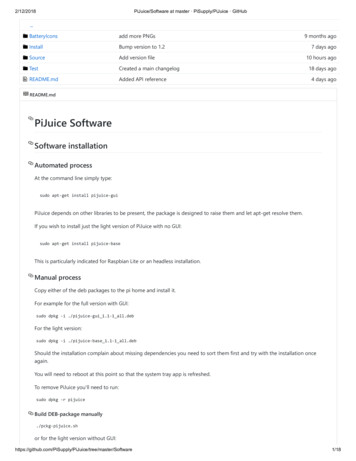
Transcription
Riichi Book IA Mahjong Strategy Primerfor European PlayersDaina Chiba
Riichi Book IA Mahjong Strategy Primer for European PlayersVersion 13Daina Chiba
Copyright 2016–2020 Daina Chiba.Permission is granted to copy, distribute, and/or modify this document under the terms of the Creative Commons Attribution NonCommercial 3.0Unported License, available at https://bit.ly/1xIMXnA.Cover photo 2015 Katarína Mózová, Courtesy of Riichi Mahjong Slovakia.The original form of this book is LATEX source code. Compiling this LATEXsource has the effect of generating a device-independent representation ofa manuscript. The LATEX source for this book is available from https://github.com/dainachiba/RiichiBooks.About the AuthorDaina Chiba is a political scientist and an applied statistician working as alecturer at the University of Essex in England. He has been playing riichimahjong for almost 20 years. He can be reached at daina.chiba@gmail.com.
PrefaceWhen I moved to England in 2013, I was pleasantly surprised tolearn that riichi mahjong (modern Japanese mahjong) is quite popular in Europe. In the past two years, I have had the pleasure of playing riichi in London, Guildford, Kent, Oxford, Aachen, Copenhagen,Prague, and Vienna, along with players from Austria, China, CzechRepublic, Denmark, Estonia, Finland, France, Germany, Italy, Japan,the Netherlands, Poland, Russia, Slovakia, Sweden, the UK, and theUnited States.European players have been remarkably successful in organizingtournaments open to anyone who plays the game. These tournaments — held at least once a month somewhere in Europe — are runby local mahjong players in each country under the auspices of theEuropean Mahjong Association (EMA).1 Founded in 2005, EMA hasbeen doing a fantastic job in maintaining common rule sets,2 keeping a player ranking system, and doing many other useful things topromote the playing of mahjong across Europe.Although I have come across a few good players in Europe, I cameto realize that a lot of players here are not very well-versed in thebasic principles of competitive mahjong strategies. Of course, playing competitively is not the only way to enjoy the game. I am also12http://mahjong-europe.org/EMA’s official rule book for riichi mahjong is available online at i-rules-2016-EN.pdf(last revised in 2016). At the time of writing this book, EMA is in the processof revising the rule book. Explanations of EMA rules in this book are based onthe revised rules. New rules will come into effect from April, 2016.
PREFACEivnot claiming that I know the magic formula to win because there isno such thing. Nevertheless, there is a set of basic principles worthlearning for any aspiring players. I believe the level of sophisticationamong European players could be much improved if these principles are more widely shared. Unfortunately, however, learning resources currently available for non-Japanese audience are somewhatlimited.3I have thus decided to write a book on riichi mahjong strategiesfor European players, primarily with beginners and intermediate players in mind. I then ended up splitting the book into two volumes;Book I is intended for beginners and intermediate players (Tenhourank of 四段 or below), while Book II is meant for more advancedplayers. The two books are not intended for complete novices whodo not know how to play riichi mahjong.4 The target reader is anyone who has played riichi mahjong before and wants to improve theirskills further.I have three main goals in preparing these books. First, I will introduce a set of English terminology of riichi mahjong. “In beginningwas Word,” scripture tells us. Knowing the names of particular tilecombinations, situations, and strategies will allow us to be consciousof them and to be able to talk about them with our fellow playersafter the game.My second goal is to introduce the principles of tile efficiency.Book I and Book II both cover tile efficiency, but at different levels.34There are already a few English books for beginners. There are also severalexcellent blog posts on technical details about mahjong strategies. However,there appears to be a huge gap between these two sets of resources. Introductory books do not cover strategies extensively, whereas blog posts tend to betoo advanced even for intermediate players.If you want to learn how to play riichi, I’d recommend Barr (2009).
vBook I offers an introduction to tile efficiency, covering very basicmechanisms only. I plan to cover more advanced materials in BookII. My third goal is to introduce a set of simple strategies regardingcritical judgements such as whether or not to call riichi, whether topush or to fold, and whether or not to meld.A lot of the materials covered in the books were introduced tome through the writings of a notable Japanese mahjong player andmanga author, Masayuki Katayama. Mr. Katayama is an accomplishedriichi player and arguably the best mahjong manga author in theworld. Some of the strategies introduced here are unabashedly stolenfrom Mr. Katayama’s masterpiece manga storybook U tahime Obakamiiko (『打姫オバカミーコ』). I strongly encourage you to read ityourself if you read Japanese, although I realize that you would notbe reading my book if you understood Japanese.Another Japanese author whose work has been influential in thewriting of Book I is Makoto Fukuchi. Mr. Fukuchi is also a distinguished riichi player and the best-selling author of mahjong strategybooks. A part of the exposition of the five-block method in Chapter4 is based on Mr. Fukuchi’s skillful explanation in his books.I am also indebted to a lot of friends I have become acquaintedwith through mahjong in Europe. Philipp Martin has read an earlydraft of the book and provided me with valuable comments andencouragement. I am also grateful to Gemma Sakamoto, who hasbeen hosting a monthly mahjong get-together in London. Finally,my thanks go to Ian Fraser, one of the founders of the UK MahjongAssociation. Without the efforts of Ian and his team, I would nothave been able to get to know so many fellow players in the UK andin Europe.
PREFACEviThe cover photo ( Katarína Mózová) is from the 2015 BratislavaRiichi Open Tournament. I thank Katarína and Riichi Mahjong Slovakia (especially Matej Labaš) for giving me their permission to useit.After I made the book publicly available in January 2016, a lot ofpeople have given me feedback on various aspects of the book. Basedon their feedback, I corrected some terminology inconsistencies andtypos. In particular, I thank David Clarke, Aaron Ebejer, Nicolas Giaconia, Grant Mahoney, Ting, Chris Rowe, Mike Liang, and Max Lufor their valuable inputs.Daina ChibaLondon, UKJanuary 10, 2016(updated on September 14, 2020)
viiPlan of the bookTo improve your mahjong skills, you need not only to learn thetheories but also to practice what you learn by playing lots of games,preferably with players who are stronger than yourself. Before theadvent of online mahjong platforms, however, doing so was not veryeasy if you live outside of Japan.Thanks to the recent development of online mahjong platforms, itis now feasible for you to play hundreds or thousands of games withserious opponents while living outside of Japan. On these websites,you can easily find fellow players to play with 24/7. Most platformskeep the record of all the games players have played and a replayfunction that allows you to reflect on your past plays. You can alsotake a look at player statistics, which gives you important clues as towhat skills you need to work on.I thus recommend you practice mahjong skills by playing onlinewhile you study the strategy principles with this book. You do notneed to wait until you finish reading everything covered in the bookbefore you start playing. Go ahead and play games first, then comeback to the book and study the relevant parts of the book.This book is divided into four parts. Part I provides an introduction to an online mahjong platform called Tenhou (天鳳). Thewebsite is in Japanese, but I will walk you through the account registration process and show you how to play games in Chapter 1. Therealready exist several excellent online resources that explain how toplay Tenhou, including: Arcturus’s Tenhou Documentationhttp://arcturus.su/tenhou/
PREFACEviii Complete Beginner’s Guide to Online Mahjong (Osamuko)https://bit.ly/2CXAKoM Playing Online: Tenhou (Reach Mahjong of New York)https://bit.ly/2sd0tU4If you have already read either of the three before, you can skip Chapter 1 of this book, for there is not much new information there for you.Chapter 2 explains some advanced features of Tenhou, which you canalso skip when you read this book for the first time.Parts II and III are the “meat” of the book. Part II covers basictile efficiency theories that allow you to maximize the speed and/orhand value of your hand. After introducing basic terminology inChapter 3, I discuss the five-block method in Chapter 4 and providesome tips on how to pursue several yaku in Chapter 5. Part III coversstrategy principles, including score calculation methods (Chapter 6),riichi judgement (Chapter 7), defense judgement (Chapter 8), melding judgement (Chapter 9), and so called “grand strategies” to wina game (Chapter 10). Finally, Appendices include a chapter on etiquettes for offline playing (Chapter A) and another chapter on further readings (Chapter B).Numbers and letters shown in this color as well as each entry inthe Contents section below are hyperlinked; clicking on one will takeyou to the pertinent page.
ContentsPrefaceiiiI Playing Riichi Online11 Introduction to Tenhou (天鳳)31.1Why play online? . . . . . . . . . . . . . . . . . . . . .31.2Setting up an account . . . . . . . . . . . . . . . . . . .41.3The main page . . . . . . . . . . . . . . . . . . . . . . .101.4Playing a game . . . . . . . . . . . . . . . . . . . . . .131.5Troubleshooting . . . . . . . . . . . . . . . . . . . . . .261.6Rules . . . . . . . . . . . . . . . . . . . . . . . . . . . .272 Advanced features of Tenhou302.1Rank and rating . . . . . . . . . . . . . . . . . . . . . .302.2Four rooms . . . . . . . . . . . . . . . . . . . . . . . . .352.3Reading the statistics . . . . . . . . . . . . . . . . . . .372.4Viewing games . . . . . . . . . . . . . . . . . . . . . .43II Basic Tile Efficiency463 Riichi mahjong basics483.1Learning strategies . . . . . . . . . . . . . . . . . . . .483.2Basic building blocks . . . . . . . . . . . . . . . . . . .503.3Complex shapes . . . . . . . . . . . . . . . . . . . . . .653.4Waits . . . . . . . . . . . . . . . . . . . . . . . . . . . .76ix
CONTENTSx3.5Glossary . . . . . . . . . . . . . . . . . . . . . . . . . .4 The five-block method82844.1Finding a redundant tile . . . . . . . . . . . . . . . . .854.2Alternative configurations . . . . . . . . . . . . . . . .884.3Selecting tile blocks . . . . . . . . . . . . . . . . . . . .974.4Building a block . . . . . . . . . . . . . . . . . . . . . . 1045 Pursuing yaku1105.1How to get sanshoku . . . . . . . . . . . . . . . . . . . 1115.2How to get ittsu . . . . . . . . . . . . . . . . . . . . . 1205.3How to get pinfu . . . . . . . . . . . . . . . . . . . . . 1255.4How to get honitsu . . . . . . . . . . . . . . . . . . . . 1285.5How to get toitoi / chiitoitsu . . . . . . . . . . . . 134III Strategy Principles1386 Scoring1406.1Three steps in score calculation . . . . . . . . . . . . . 1406.2Basic scoring . . . . . . . . . . . . . . . . . . . . . . . . 1426.3Advanced scoring . . . . . . . . . . . . . . . . . . . . . 1536.4Scoring tables . . . . . . . . . . . . . . . . . . . . . . . 1617 Riichi judgement1637.1To riichi or not to riichi? . . . . . . . . . . . . . . . . . 1637.2Insta-riichi . . . . . . . . . . . . . . . . . . . . . . . . . 1667.3When not to riichi . . . . . . . . . . . . . . . . . . . . . 1767.4Glossary . . . . . . . . . . . . . . . . . . . . . . . . . . 1888 Defense judgement8.1189To push or to fold? . . . . . . . . . . . . . . . . . . . . 189
CONTENTSxi8.2Defense basics . . . . . . . . . . . . . . . . . . . . . . . 1938.3Defense against riichi . . . . . . . . . . . . . . . . . . . 2048.4Defense against open hands . . . . . . . . . . . . . . . 2088.5Glossary . . . . . . . . . . . . . . . . . . . . . . . . . . 2159 Melding judgement2169.1To meld or not to meld? . . . . . . . . . . . . . . . . . 2169.2Melding choice: examples . . . . . . . . . . . . . . . . 2199.3Calling kan . . . . . . . . . . . . . . . . . . . . . . . . . 2259.4Miscellaneous tips for melding . . . . . . . . . . . . . 23110 Grand strategies23510.1 What to do in South-4 . . . . . . . . . . . . . . . . . . 23510.2 What to do by South-3 . . . . . . . . . . . . . . . . . . 24410.3 Tables for induced point differences . . . . . . . . . . 247AppendicesA Manners for offline playing250A.1 Dealing tiles . . . . . . . . . . . . . . . . . . . . . . . . 250A.2 Drawing and discarding . . . . . . . . . . . . . . . . . 252A.3 Calling . . . . . . . . . . . . . . . . . . . . . . . . . . . 254A.4 Winning a hand . . . . . . . . . . . . . . . . . . . . . . 255B Further readings260B.1 Books on riichi mahjong . . . . . . . . . . . . . . . . . 260B.2 Online resources . . . . . . . . . . . . . . . . . . . . . . 262
Part IPlaying Riichi Online1
Chapter 1Introduction to Tenhou (天鳳)1.1Why play online?Playing mahjong online is an excellent way to practice your mahjongskills. You don’t need any mahjong equipment to play; you don’tneed to coordinate with your mahjong friends to find the time andplace that work for all four of you. You can simply open your computer and access one of many online mahjong platforms. As longas you have an internet connection, you can play mahjong any time,anywhere, and for any length of time.Another advantage of online playing is that you can easily keepthe record of your playing history and obtain detailed statistics fromall the games you play. Analyzing these statistics will help you identify what skill sets you need to work on. You can also show yourgame record to your friends and ask for their opinions about particular choices you’ve made in a game.天 鳳 (Tenhou) is arguably themost popular online mahjong platform in the world. As of December,2015, there are over three hundredthousand active players on Tenhou.1A lot of professional mahjong players from Japan now play Tenhou.There are also some Tenhou players who have later become professional after practicing their skills on Tenhou. It has become a common1To be exact, it has 304,534 active players and 3,566,353 registered players as of20 December, 2015.
4CHAPTER 1. INTRODUCTION TO TENHOU (天鳳)understanding among players in Japan that your rank and rating onTenhou are one of the most reliable indicators of your mahjong skilllevels. To get you started, this chapter explains how to set up an account on Tenhou and provides a basic operation manual.1.2Setting up an accountOne of the challenges for European players in setting up an account on Tenhou would be that almost everything is written in Japanese.However, you will only need a minimal level of Japanese to get by,and this chapter will walk you through the process.First, go to the Tenhou webpage (http://tenhou.net/).Scroll down and click either the PLAY button (to play in a pop-upwindow) or a link just below the button (to play in the current window) that reads このウィンドウで開く.Click here to playin a pop-upwindow.Click this link toplay in thecurrent window.
1.2. SETTING UP AN ACCOUNT5Then, on the next page (either in a pop-up window or in the current window), you’ll see something like the following:Flash versionWeb versionThe bottom line will initially read LOADING. / 再読み込み, butin a few seconds it will change into »Flash 版サーバに接続 Web 版β サーバに接続. Then, click on the Flash サーバに接続 link if you areaccessing from a flash-capable device such as your PC; alternatively,click on the Web 版 β サーバに接続 link if you are accessing from asmart phone or tablet. If it doesn’t change into »Flash 版サーバに接続 Web 版 β サーバに接続 within 10 seconds or so, you may wantto click on the 再読み込み link right next to LOADING, which willprompt the browser to reload the page. Clicking on either of theFlash/Web サーバに接続 links will take you to the log-in entrance ofTenhou. Explanations below are based on the Flash version.
CHAPTER 1. INTRODUCTION TO TENHOU (天鳳)6RegistrationID field (likely to be blank at first)When you first visit this page, the ID field right next to the 新規ID 登録 button is likely to be blank, as shown in the picture above.This is because you haven’t registered an account. In order to createan account, click on the 新規 ID 登録 (New ID Registration) buttonon the left.A pop-up message will show up, warning you that whatever IDthat is currently shown in the ID field (if any) will be overwrittenwith a new ID and that you may want to copy and paste the currentID (if any) into some text file or similar. Do so if you do see an oldID in the ID field, just to be safe. If the ID field is blank, just click theYes button, which will open yet another pop-up message.
1.2. SETTING UP AN ACCOUNT7It is telling you the following: You can create a player ID for free, and doing so is necessary ifyou want to earn a rank (kyuu / dan) and rating. Some characters or character combinations are not allowed inplayer names. Once you register, you cannot register another account for agiven period (7 days). If you don’t play for 180 days, your ID may be deleted. A player name must have 1-8 characters.Type in a player name you’d like to have (8 characters or fewer)into the blank field at the bottom and click OK. You cannot changeyour player name later, so choose wisely. If the player name you typein is already taken by another player, it gives you an error message,as follows:This player name is taken.Click OK, and type in another name. If successful, you’ll see anew message asking you to confirm that you want to register an account with the player name provided.
8CHAPTER 1. INTRODUCTION TO TENHOU (天鳳)Click Yes and you’ll see another message as follows:The 19-digit alpha-numeric code that starts with “ID” (shown inwhite on a black background) is your unique player ID (it is ID12345678ABCDEFGH in the picture above). I suggest you save your ID in atext file or something so that you don’t lose it. They cannot re-issueyour player ID (unless you have a paid membership and hold a rankof 七段 or higher).Clicking OK will take you back to the log-in entrance page, butthis time you should see your player ID in the ID field.
1.2. SETTING UP AN ACCOUNT9Can chooseプレミアム orエコノミー.Your player IDChoose 男 (male voice) or 女 (female voice)You can make several choices before entering the main page. First,you can choose male or female voice (for pon / chii / riichi, etc.) byclicking on the button right next to the ID field. You can choose adifferent gender each time you log in to the main lobby. Second, youcan choose プレミアム (premium) or エコノミー (economy) version.The premium version has better graphics, so I suggest you choosethe premium version.If you are happy with your choices, you can enter the main pageby clicking on the OK button on the right.
CHAPTER 1. INTRODUCTION TO TENHOU (天鳳)101.3The main pageHere is what the Tenhou main page looks like when you first logon in. The right half of the main page shows your statistics (currentlyall the fields are blank because you haven’t played any games), andthe left half shows the games you can play and some other features.Main tabsSub tabsMenuCancel (to cancel a reservation)In the second line of the left hand side, you see three numbers. Inthe example above, they are 1857, 915, and 118 (the numbers will bedifferent on your screen). These numbers show that 1857 players arecurrently online, 915 players are waiting, and 118 players are aboutto finish their games.Below these three numbers, there are six main tabs, which read 段位戦, 雀荘 β, 技能 β, 観戦, 牌譜, and ヘルプ. The 段位戦 tab is the mainlobby where we play games (段位戦 reads dan-i-sen in Japanese; itmeans ranking matches). Under the 段位戦 tab, there are four subtabs, which read 一般, 上級, 特上, and 鳳凰, corresponding to four
1.3. THE MAIN PAGE11different rooms. At first you can only play at tables in the 一般 room.Let’s first go to the 段位戦 tab, and choose the 一般 sub tab.Making reservationsIn each of the four rooms (i.e., 一般, 上級, 特上, and 鳳凰), thereare 12 different variants of riichi mahjong games you can choose from.Games in the left column (under 東風戦 tonpusen) are East-onlygames,2 and games in the right column (under 東南戦 tonnansen)are more standard East-South games that have both East and Southrounds.31 player waitingClosed tanyao44 players playingOpen tanyaoWith red fivesFastThree-playerFast (3p)East-onlyEast–SouthGames in the first row (喰断ナシ kuitan nashi) are unusual gameswhere open tanyao (All Simples) is not allowed; you have to havea concealed hand to claim tanyao.4 There are no red fives in thesegames, either. Open tanyao is allowed in all the other games. Games234In a special circumstance where no player gets 30000 or more points by the endof East-4, the game continues into the South round.Just like East-only games, when there is no player who has 30000 or more pointsby the end of South-4, the game continues into the West round.kuitan means “open tanyao” and kuitan nashi means “without kuitan” inJapanese.
12CHAPTER 1. INTRODUCTION TO TENHOU (天鳳)in the second row are more standard games with open tanyao, butthey do not have red fives. Games in the third row have three redfives. This is arguably the most standard type of riichi mahjong gameplayed in Japan as of now. Games in the fourth row have the samerule as those in the third, but the time limit on each action is morestrict. Games in the fifth and sixth rows are three-player games,where open tanyao and red fives are both allowed.The set of numbers delimited by a colon in each cell representthe numbers of players currently waiting and playing the game, respectively. For example, the first row in the left column shows 3:24,which means that 3 players are waiting in queue after signing up fora game, and 24 players are currently playing East-only, closed tanyaogames. As it happens, East-South games with red fives are usuallythe most popular on Tenhou, followed by East-only, fast games.To sign up for a game, click on the 予約 (reservation) button inthe corresponding cell. You can make as many reservations as youwant; you will be given a seat at a table that first becomes available. Ifyou make multiple reservations, other reservations will be automatically canceled when you start playing at another table. To cancel allthe reservations at once, click on the キャンセル (Cancel) button atthe bottom right of the left-hand side of the main page. The cancelbutton becomes active (clickable) only after you make a reservation.
1.4. PLAYING A GAME1.413Playing a gameOnce a slot becomes available foryou, you will be taken to a game table along with three other players. Ablack pop-up screen (see right) willappear. The game will start in 10 seconds (if all the four players click onthe OK button, the game will startimmediately). Each player is randomly assigned to East, West, South, or North. In the example above,my initial seat wind is North (北).The Tenhou interface is quite intuitive so you won’t need muchinstruction. Once a hand begins, tiles are dealt automatically. Youalso automatically draw a tile when your turn comes. In each turn,click on the tile you want to discard.Each action is timed. At a standard (non fast) table, you have 5seconds to discard a tile. In addition, you are given a total allowanceof 10 seconds in each hand. That is, even when you use up the 5 sec-
14CHAPTER 1. INTRODUCTION TO TENHOU (天鳳)onds allocated to you in a particular turn, you will be given the maximum 10 additional seconds (minus the seconds you have alreadyused up in previous turns in the hand). For example, when you use5 4 seconds in the first turn, the remaining allowance reduces to10 4 6 seconds in this hand. Therefore, the next time you useup the first 5 seconds, you will be given only 6 more seconds. Theallowance will increase by 1 second (up to 10 seconds) each time youmake your discard choice in less than 1 second. The allowance willrevert to 10 seconds when the next hand begins. At fast tables, eachaction must be done in 3 seconds, with a total allowance of 5 seconds.1.4.1 Calling / meldingWhen a call becomes available, a box with a call name will showup to prompt your reaction. The call prompts are written in Japanese.The good news is that they are relatively simple and easy to guessfrom the context. It would be enough to memorize the followingeight mahjong words in Japanese.1. リーチ riichi [rÍ:tS]You can call riichi when you have (1) a closed ready hand, (2) atleast 1000 points left, and (3) at least one turn left to draw. When allof the three conditions are met, a translucent box that reads リーチin white letters will pop up in your turn.If you want to riichi, you must click on the リーチ box first, then clickon the tile you want to discard. Once you click on the リーチ box, youcannot call it off. Clicking on the リーチ box also makes it impossibleto discard a tile that does not make the hand ready. In the above ex-
1.4. PLAYING A GAME15ample, tiles other than ıȷfi” will become unclickable once youclick on the リーチ box. If you do not want to call riichi, just click onthe tile you want to discard.2. ロン ron [rÓN]A ロン box will pop up whenever you can legitimately declareron on an opponent’s discard. In other words, chombo is made impossible on Tenhou. For example, when you are furiten, a ロン boxwill not pop up because you cannot legally ron with a furiten hand.Whenever your hand is in a furiten status, it is indicated with a フリテン (furiten) sign in small translucent letters below your handthat looks like:. If you don’t click on the ロン box in time(i.e., in 5 or 3 seconds allowance), it is assumed that you pass.3. パス Pass (do nothing)Whenever a ロン box pops up, another box that reads パス (pass)will accompany it.Click on the パス box immediately if you don’t want to declare ronon a discard. You would not want to pause for too long because thatcan look suspicious. A パス box will also pop up when other callingactions become available.4. ツモ tsumo [tsúmo]A ツモ box will pop up when you can legitimately declare tsumowith your draw.
CHAPTER 1. INTRODUCTION TO TENHOU (天鳳)165. ポン pon [pÓN]When calling pon becomes available, a ポン box will pop up rightabove the tiles in your hand with which to call pon. A パス box willalso pop up. If you want to call pon, mouse over the tiles in yourhand with which to call pon. Then the candidate tiles will stick out,as follows:Click on them to call pon. If you click on the パス box or don’t doanything in time, it is assumed that you pass.6. チー chii [tSÍ:]Chii calls are done in a similar way. When it becomes available,a small sign that reads チー will pop up right above the tiles in yourhand with which to call chii.When you have multiple sets of tiles with which to chii, as is thecase in the above picture, mouse over the candidate tiles to choose.In the picture above, the left player discarded a “ and you can chiiit with either ‹›, ›”, or ”„. If you want to chii it with ‹›,mouse over the ‹ then the ‹ and the › will stick out so you canclick on them. If you want to chii it with ›”, mouse over the ›then the › and a ” will stick out so you can click on them. Finally,if you want to chii it with ”„, mouse over the left ” then the ”and the „ will stick out so you can click on them.
1.4. PLAYING A GAME177. カン kan [k2́N]Calling kan on a discard is similar to calling pon. Calling kan byextending a melded pon may be a little bit confusing at first. Whenyou have a melded pon and there is the fourth tile in your hand(newly drawn or previously drawn), a small sign that reads カンwill appear below the pon upon your turn. If you want to extendthe melded pon, mouse over the melded pon then the fourth tile willstick out. Click on the melded pon to extend the pon. To call a concealed kan, mouse over the four tiles you want to kan then the tileswill stick out, accompanied by a small sign that reads カン belowthem. Click on them to call kan.8. 九種九牌 Kyuushu KyuuhaiWhen you have nine different terminals and honors after the firstdraw in an uninterrupted first set of turns, you can declare an abortivedraw. When this becomes available, a box that reads 九種九牌 willpop up. Click on it if you want to declare an abortive draw. If youwish to continue with the hand, just click on the tile you want to discard.Multiple boxesSometimes you have multiple choices as to what to do with agiven discard of your opponent. In the following example, you havea ready hand waiting for —-ı, and the left player discarded a ı.You will be given the following three choices:RonChiiPass
CHAPTER 1. INTRODUCTION TO TENHOU (天鳳)18 Call ron Call chii Pass (do nothing)To call ron on the discarded ı, click on the ロン (ron) box that popsup above your hand. If you want to do nothing, click on the パス(pass) box right next to the ロン box. Alternatively, if you want tocall chii, mouse over the two tiles you want to chii with (in thiscase ‰) and click on them.1.4.2 ButtonsThe buttons at the bottom right corner allow you to toggle on/offsome calling-related features. Each feature is turned off at the beginning of a new hand.Sound (音)Auto discard drawAuto call winNo callPicture (画)自動和了 (Auto call win)If you turn this on, you will automatically win a hand when possible without clicking on ロン or ツモ boxes. In other words, the optionof passing is unavailable when this is turned on. Keep in mind thatthis can be problematic at times when you intend not to win yourhand from a particular opponent or on a particular tile. When thisis turned on, the word 自動和了 is shown in white; when it is turnedoff, it is translucent. In the picture above, it is turned on.ツモ切り (Auto discard dra
v Book I ff an introduction to tile ffi, covering very basic mechanisms only. I plan to cover more advanced materials in Book II. My third goal is to introduce a set of simple strategies regarding










